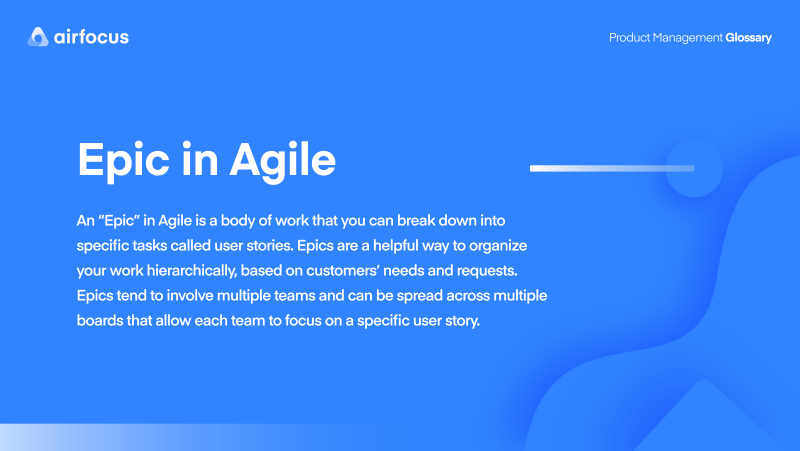Epics in Agile and Scrum
What is an Epic in Agile?
Epic in Agile definition
An “Epic” in Agile is a body of work that you can break down into specific tasks called user stories. Epics are a helpful way to organize your work hierarchically, based on customers’ needs and requests. Epics tend to involve multiple teams and can be spread across multiple boards that allow each team to focus on a specific user story.
While an epic may sound similar to a sprint, epics are usually larger in scale and are spread between multiple sprints. During that time, each team will learn more about the epic through development and feedback, leading to user stories being added or dropped as required. Like with all Agile work, epics require a strong level of flexibility from teams and the ability to adapt quickly.
What are Epics and Features in Scrum?
While epics, features, and user stories are all linked, they refer to very different things.
Epic
Epics refer to the overall body of work that needs to be completed. An epic is a significant piece of work that will strategically add value to your product and business.
Feature
A feature is a subsection of the epic. Features are deliverables that add value and move towards completing the epic.
User story
A user story is a subsection of a feature. User stories are short requirements or requests written from the perspective of an end user.
What is a User Story in an Epic?
User stories are small parts of an Epic. They are written from the end user’s perspective to allow the developers to look at the product or feature they’re working on from an outside point of view. A user story should describe a specific customer need that the team can address with a new feature or by changing an existing feature.
User stories tend to follow this template:
As a...
I want...
So that…
Say a customer is looking for an easier way to log into their account, the user story would look something like this:
As a: regular user
I want: to be able to log in with different options
So that: I can use my Google account to log into my account more easily.
What is the difference between an Epic and a User Story in Agile?
An epic is made up of user stories, but each is told from a different perspective. So while epics are told from the perspective of the business and dictate what they hope to achieve, user stories are smaller pieces of that epic puzzle that allows the developers to understand what the customer expects from the overall epic.
Does every Story need an Epic?
While most tools require an epic to be defined before breaking down into user stories, user stories can stand on their own. There is nothing stopping developers from skipping an epic altogether and simply focusing on the individual user stories.

General FAQ

Glossary categories
Experience the new way of doing product management

Experience the new way of doing product management








